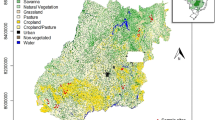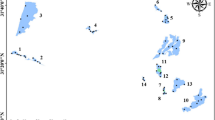Abstract
The variation in thermal regime and elevation among streams in the Sawtooth Mountains of Idaho, USA was used to test hypotheses about forces structuring larval mayfly assemblages. Sites above and below lakes were included to maximize variation in thermal regime. Forty-five sites were sampled for mayfly larvae and their summer thermal regime was measured. Ordination methods were used to analyze variation in the mayfly assemblages. Principal components analysis showed that mayfly assemblages were strongly and consistently affected by lakes within the stream system, apparently through the effects of lakes on stream temperature. Redundancy analysis explained 51% of the variation in assemblages and identified maximum water temperature and elevation as strong predictors of mayfly assemblages. Elevation influenced assemblage structure independently of summer maximum water temperature, suggesting that air temperature or some other elevation-dependent feature is also important. As predicted by the River Continuum Concept, mayfly diversity increased with increasing maximum daily range in temperature.






Similar content being viewed by others
References
Adams, J., 2004. Stream bugs as biomonitors: a guide to Pacific Northwest macroinvertebrate monitoring and identification. The Xerces Society, Portland, Oregon.
Arp, C. D., M. N. Gooseff, M. A. Baker & W. Wurtsbaugh, 2006. Surface-water hydrodynamics and regimes of a small mountain stream-lake ecosystem. Journal of Hydrology 329: 500–513.
Briers, R. A., H. M. Cariss & J. H. R. Gee, 2003. Flight activity of adult stoneflies in relation to weather. Ecological Entomology 28: 31–40.
Brittain, J. E., E. Castella, S. Knispel, V. Lencioni, B. Lods-Crozet, B. Maiolini, A. M. Milner, S. J. Slatveit & D. L. Snook, 2003. Ephemeropteran and Plecopteran communities in glacial rivers. In Gaino, E. (ed.), Research Update on Ephemeroptera and Plecoptera. University of Perugia, Perugia, Italy.
Brussock, P. P. & A. V. Brown, 1991. Riffle-pool geomorphology disrupts longitudinal patterns of stream benthos. Hydrobiologia 220: 109–117.
Cao, Y., D. P. Larsen, R. M. Hughes, P. L. Angermeier & T. M. Patton, 2002. Sampling effort affects multivariate comparisons of stream assemblages. Journal of the North American Benthological Society 21: 701–714.
Doberstein, C. P., J. R. Karr & L. L. Conquest, 2000. The effect of fixed-count subsampling on macroinvertebrate biomonitoring in small streams. Freshwater Biology 44: 355–371.
Edmunds, G. F. Jr. & R. D. Waltz, 1996. Ephemeroptera. In Merritt, R. W. & K. W. Cummins (eds), An Introduction to the Aquatic Insects of North America, 3rd edn. Kendall/Hunt Publishing Co., Dubuque, Iowa.
Finn, D. S. & N. L. Poff, 2005. Variability and convergence in benthic communities along the longitudinal gradients of four physically similar Rocky Mountain streams. Freshwater Biology 50: 243–261.
Haidekker, A. & D. Hering, 2007. Relationship between benthic insects (Ephemeroptera, Plecoptera, Coleoptera, Trichoptera) and temperature in small and medium-sized streams in Germany: a multivariate study. Aquatic Ecology. doi:10.1007/s10452-007-9097-z.
Harding, J. S., 1992. Physico-chemical parameters and invertebrate faunas of three lake inflows and outlets in Westland, New Zealand. New Zealand Journal of Marine and Freshwater Research 26: 95–102.
Harding, J. S., 1994. Variation in benthic fauna between differing lake outlet types in New Zealand. New Zealand Journal of Marine and Freshwater Research 28: 417–437.
Hawkins, C. P., J. M. Hogue, L. M. Decker & J. W. Feminella, 1997. Channel morphology, water temperature, and assemblage structure of stream insects. Journal of the North American Benthological Society 16: 728–749.
Hieber, M., C. T. Robinson, U. Uehlinger & J. V. Ward, 2005. A comparison of benthic macroinvertebrate assemblages among different types of alpine streams. Freshwater Biology 50: 2087–2100.
Jacobsen, D., R. Schultz & A. Encalada, 1997. Structure and diversity of stream invertebrate assemblages: the influence of temperature with altitude and latitude. Freshwater Biology 38: 247–261.
Jongman, R. H. G., C. J. F. ter Braak & O. F. R. van Tongeren, 1995. Data Analysis in Community and Landscape Ecology. Cambridge University Press, Cambridge.
Kamler, E., 1965. Thermal conditions in mountain waters and their influence on the distribution of Plecoptera and Ephemeroptera larvae. Ekologia Polska – Seria A 20: 1–38.
Kling, G. W., G. W. Kipphut, M. M. Miller & W. J. O’Briens, 2000. Integration of lakes and streams in a landscape perspective: the importance of material processing on spatial patterns and temporal coherence. Freshwater Biology 43: 477–497.
Li, J., A. Herlihy, W. Gerth, P. Kaufmann, S. Gregory, S. Urquhart & D. Larsen, 2001. Variability in stream macroinvertebrates at multiple spatial scales. Freshwater Biology 46: 87–97.
Malmqvist, B., 2002. Aquatic invertebrates in riverine landscapes. Freshwater Biology 47: 679–694.
Malmqvist, B. & A. Eriksson, 1995. Benthic insects in Swedish lake-outlet streams: patterns in species richness and assemblage structure. Freshwater Biology 34: 285–296.
Minshall, G. W., R. C. Petersen Jr. & C. F. Nimz, 1985. Species richness in streams of different size from the same drainage basin. American Naturalist 125: 16–38.
Miserendino, M. L., 2001. Macroinvertebrate assemblages in Andean Patagonian rivers and streams: environmental relationships. Hydrobiologia 444: 147–158.
Ott, D. S. & T. R. Maret, 2003. Aquatic assemblages and their relation to temperature variables of least-disturbed streams in the Salmon River Basin, central Idaho, 2001. United States Geological Survey Water-Resources Investigations Report 03-4076.
Parsons, M., M. C. Thoms & R. H. Norris, 2003. Scales of macroinvertebrate distribution in relation to the hierarchical organization of river systems. Journal of the North American Benthological Society 22: 105–122.
Perry, S. A. & A. L. Sheldon, 1986. Effects of exported seston on aquatic insect faunal similarity and species richness in lake outlet streams in Montana, USA. Hydrobiologica 137: 65–77.
Richardson, J. S. & R. J. Mackay, 1991. Lake outlets and the distribution of filter feeders: an assessment of hypotheses. Oikos 62: 370–380.
Robinson, C. T. & G. W. Minshall, 1990. Longitudinal development of macroinvertebrate communities below oligotrophic lake outlets. Great Basin Naturalist 50: 303–311.
Sponseller, R. A., E. F. Benfield & H. M. Valett, 2001. Relationships between land use, spatial scale and stream macroinvertebrate communities. Freshwater Biology 46: 1409–1424.
Sweeney, B. W, 1978. Bioenergetic and developmental response of a mayfly to thermal variation. Limnology and Oceanography 23: 461–477.
Vannote, R. L., G. W. Minshall, K. W. Cummins, J. R. Sedell & C. E. Cushing, 1980. The river continuum concept. Canadian Journal of Fisheries and Aquatic Science 37: 130–137.
Vinson, M. R. & C. P. Hawkins, 1996. Effects of sampling area and subsampling procedure on comparisons of taxa richness in streams. Journal of the North American Benthological Society 15: 392–399.
Vinson, M. R. & C. P. Hawkins, 1998. Biodiversity of stream insects: variation at local, basin, and regional scales. Annual Review of Entomology 1998: 271–293.
Ward, J. V. & J. A. Stanford, 1982. Thermal responses in the evolutionary ecology of aquatic insects. Annual Review of Entomology 27: 97–117.
Wotton, R. S., 1988. Very high secondary production at a lake outlet. Freshwater Biology 20: 341–346.
Wotton, R.S, 1995. Temperature and lake-outlet communities. Journal of Thermal Biology 20: 121–125.
Wright, K. K. & J. L. Li, 2002. From continua to patches: examining stream community structure over large environmental gradients. Canadian Journal of Fisheries and Aquatic Science 59: 1404–1417.
Wurtsbaugh, W. A., M. A. Baker, H. P. Gross & P. D. Brown, 2005. Lakes as nutrient “sources” for watersheds: a landscape analysis of the temporal flux of nitrogen through sub-alpine lakes and streams. Verhandlungen der Internationale Vereinigung für Theoretische und Angewandte Limnologie 29: 645–649.
Yuan, L. L., 2007. Effects of measurement error on inferences of environmental conditions. Journal of the North American Benthological Society 26: 152–163.
Zar, J. H., 1996. Biostatistical Analysis, 3rd edn. Prentice Hall, New Jersey.
Acknowledgments
The National Science Foundation (Award DEB 01-32983 and an ROA Supplement to that award), Texas Lutheran University, and Utah State University provided financial and logistical support. I thank Wayne Wurtsbaugh and Bob Hall for aid in the development of the project, and Wayne Wurtsbaugh for generously hosting my visit at Utah State University and commenting on the manuscript. Chris Arp and Jessie Garrett provided much useful information on study sites and temperature monitoring. Two anonymous reviewers provided many helpful comments on the manuscript.
Author information
Authors and Affiliations
Corresponding author
Additional information
Handling editor: R. Bailey
Electronic supplementary material
Below is the link to the electronic supplementary material.
Rights and permissions
About this article
Cite this article
Gustafson, M.P. Effects of thermal regime on mayfly assemblages in mountain streams. Hydrobiologia 605, 235–246 (2008). https://doi.org/10.1007/s10750-008-9357-5
Received:
Revised:
Accepted:
Published:
Issue Date:
DOI: https://doi.org/10.1007/s10750-008-9357-5




